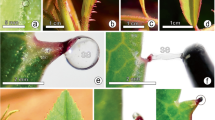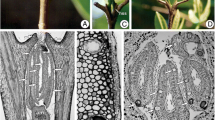Abstract
Although studies have addressed the chemical analysis and the biological activity of oleoresin in species of Copaifera, the cellular mechanisms of oleoresin production, storage, and release have rarely been investigated. This study detailed the distribution, ontogeny, and ultrastructure of secretory cavities and canals distributed in leaf and stem, respectively, of Copaifera trapezifolia, a Brazilian species included in a plant group of great economic interest. Axillary vegetative buds, leaflets, and portions of stem in primary and secondary growth were collected and processed in order to study the anatomy, histolocalization of substances, and ultrastructure. Secretory cavities are observed in the foliar blade and secretory canals in the petiolule and stem. They are made up of a uniseriate epithelium delimiting an isodiametric or elongated lumen. Biseriate epithelium is rarely observed and is a novelty for Leguminosae. Cavities and canals originate from ground meristem cells and the lumen is formed by schizogenesis. The content of the cavities and canals of both stem and leaf is oily and resinous, which suggests that the oleoresin could be extracted from the leaf instead of the stem. Phenolic compounds are also detected in the epithelial cell cytoplasm. Cavities and canals in the beginning of developmental stages have polarized epithelial cells. The cytoplasm is rich in smooth and rough endoplasmic reticula connected to vesicles or plastids. Smooth and rough endoplasmic reticulum and plastids were found to be predominant in the epithelial cells of the secretory cavities and canals of C. trapezifolia. Such features testify the quantities of oleoresin found in the lumen and phenolic compounds in the epithelial cell cytoplasm of these glands. Other studies employing techniques such as correlative light electron microscopy could show the vesicle traffic and the compartmentalization of the produced substances in such glands.





Similar content being viewed by others
References
Alencar JC (1982) Estudos silviculturais de uma população natural de Copaifera multijuga Hayne—Leguminosae, na Amazônia Central. 2—Produção de óleo-resina. Acta Amaz 12:79–82
Benayoun J, Fahn A (1979) Intracellular transport and elimination of resin from epithelial duct-cells of Pinus halepensis. Ann Bot 43:179–181
Braga WF, Rezende CM, Antunes OAC (1998) Terpenoids from Copaifera cearensis. Phytochemistry 49:263–264
Fahn A (1979) Secretory tissues in plants. Academic Press, London
Fahn A (1988) Secretory tissues in vascular plants. New Phytol 108:229–257
Falcão HS, Lima IO, Santos VL, Dantas HF, Diniz MFFM, Barbosa-Filho JM, Batista LM (2005) Review of the plants with anti-inflammatory activity studied in Brazil. Rev Bras Farmacogn 15:381–391
Joel DM, Fahn A (1980a) Ultrastructure of the resin ducts of Mangifera indica L. (Anacardiaceae). 1. Differentiation and senescence of the shoot ducts. Ann Bot 46:225–233
Joel DM, Fahn A (1980b) Ultrastructure of the resin ducts of Mangifera indica L. (Anacardiaceae). 2. Resin secretion in the primary stem ducts. Ann Bot 46:779–783
Joel DM, Fahn A (1980c) Ultrastructure of the resin ducts of Mangifera indica L. (Anacardiaceae). 3. Secretion of the protein–polysaccharide mucilage in the fruit. Ann Bot 46:785–790
Johansen DA (1940) Plant microtechnique. McGraw-Hill, New York
Karnovsky MJ (1965) A formaldehyde–glutaraldehyde fixative of high osmolarity for use in electron microscopy. J Cell Biol 27:137A–138A
Kraus JE, Arduin M (1997) Manual básico de métodos em morfologia vegetal. Seropédica, Rio de Janeiro
Lee YT, Langenheim JH (1975) A systematic revision of the genus Hymenaea (Leguminosae; Caesalpinioideae; Detarieae). Univ Calif Publ Bot 69:1–109
Lersten NR, Curtis JD (1986) Tubular cavities in white snakeroot, Eupatorium rugosum (Asteraceae). Am J Bot 73:1016–1021
Lersten NR, Curtis JD (1994) Leaf anatomy in Caesalpinia and Hoffmannseggia (Leguminosae, Caesalpinioideae) with emphasis on secretory structures. Plant Syst Evol 192:231–255
Lersten NR, Curtis JD (1996) Survey of leaf anatomy, especially secretory structures, of tribe Caesalpinieae (Leguminosae, Caesalpinioideae). Plant Syst Evol 200:21–39
Lewis GP, Schrire B, Mackinder B, Lock M (2005) Legumes of the world. Royal Botanic Gardens, Kew
Marcati CR, Angyalossy-Alfonso V, Benetati L (2001) Anatomia comparada do lenho de Copaifera langsdorffii Desf. (Leguminosae–Caesalpinoideae) de floresta e cerradão. Rev Bras Bot 24:311–320
May PH, Barata LES (2004) Rosewood exploitation in the Brazilian Amazon: options for sustainable production. Econ Bot 58:257–265
Monteiro WR, Giulietti AM, Mazzoni SC, Castro MM (1979) Hairs on reproductive organs of some Eriocaulaceae and their taxonomic significance. Bol Bot Univ de São Paulo 7:43–59
Monteiro WR, Fahn A, Caldeira W, Castro MM (1999) Ultrastructural observations on the foliar secretory cavities of Porophyllum lanceolatum DC. (Asteraceae). Flora 194:113–126
Monti H, Tiliacos N, Faure R (1999) Copaiba oil: isolation and characterization of a new diterpenoid with the dinorlabdane skeleton. Phytochemistry 51:1013–1015
Myers N, Mittermeier RA, Mittermeier CG, Fonseca GAB, Kent J (2000) Biodiversity hotspots for conservation priorities. Nature 403:853–858
Paiva EAS, Machado SR (2007) Structural and ultrastructural aspects of ontogenesis and differentiation of resin secretory cavities in Hymenaea stignocarpa (Fabaceae–Caesalpinoideae) leaves. Nord J Bot 24:423–431
Paiva EAS, Oliveira DMT (2004) Ontogenesis of the fruit pulp layer of Hymenaea stigonocarpa (Fabaceae: Caesalpinioideae). Aust J Bot 52:677–683
Paiva EAS, Oliveira DMT, Machado SR (2008) Anatomy and ontogeny of the pericarp of Pterodon emarginatus Vogel (Fabaceae, Faboideae), with emphasis on secretory ducts. An Acad Bras Ciênc 80:455–465
Parham RA, Kaustinen HM (1977) On the site of tannin synthesis in plant cells. Bot Gaz 138:465–467
Reserva da Biosfera da Mata Atlântica (RBMA) (2003) http://www.rbma.org.br/anuario/mata_01_sintese.asp. Accessed 24 November 2008
Reynolds ES (1963) The use of lead citrate at high pH as an electron-opaque stain in electron microscopy. J Cell Biol 17:208–212
Rodrigues TM, Machado SR (2009) Developmental and structural features of secretory canals in root and shoot wood of Copaifera langsdorffii Desf. (Leguminosae–Caesalpinioideae). Trees 23:1013–1018
Rodrigues TM, Teixeira SP, Machado SR (2011) The oleoresin secretory system in seedlings and adult plants of copaíba (Copaifera langsdorffii Desf., Leguminosae–Caesalpinioideae). Flora 206:585–594. doi:10.1016/j.flora.2010.10.002
Santos SC, Mello JCP (2007) Taninos. In: Simões CMO, Schenkel EP, Gosmann G, Mello JCP, Mentz LA, Petrovick PR (eds) Farmacognosia: da planta ao medicamento, 6th edn. Editora da UFRGS, Porto Alegre
Sartori ALB, Tozzi AMGA (2002) Comparative leaflet anatomy in Myrocarpus Allemão, Myroxylon L.f. and Myrospermum Jacq. (Leguminosae–Papilionoideae–Sophoreae) species. Bot J Linn Soc 140:249–259
Sass JE (1951) Botanical microtechnique. Iowa State College Press, Ames
Staehelin LA (1997) The plant ER: a dynamic organelle composed of a large number of discrete functional domains. Plant J 11:1151–1165
Teixeira SP, Gabrielli AC (2000) Anatomia do eixo vegetativo de Dahlstedtia pinnata (Benth.) Malme e D. pentaphylla (Taub.) Burk. (Leguminosae, Papilionoideae). Braz J Bot 23:1–11
Teixeira SP, Rocha JF (2009) Oil glands in the Neotropical genus Dahlstedtia Malme (Leguminosae, Papilionoideae, Millettieae). Braz J Bot 32:33–40
Teixeira SP, Castro MM, Tozzi AMGA (2000) Secretory cavities and pellucid dots in leaflets of Lonchocarpus (Leguminosae, Papilionoideae, Millettieae). Plant Syst Evol 221:61–68
Turner GW (1986) Comparative development of secretory cavities in the tribes Amorpheae and Psoraleeae (Leguminosae: Papilionoideae). Am J Bot 73:1178–1192
Turner GW (1999) A brief history of the lysigenous gland hypothesis. Bot Rev 65:76–88
Veiga VF Jr, Pinto AC (2002) O Gênero Copaifera L. Quim Nova 25:273–286
Veiga VF Jr, Zunino L, Calixto JB, Patitucci ML, Pinto AC (2001) Phytochemical and antioedematogenic studies of commercial copaíba oils available in Brazil. Phytother Res 15:476–480
Veiga VF Jr, Andrade MA Jr, Ferraz IDK, Christo HB, Pinto AC (2007) Constituintes das sementes de Copaifera officinalis L. Acta Amaz 37:123–126
Vieira RC, Delpetre PG, Leitão GG, Leitão SG (2001) Anatomical and chemical analyses of leaf secretory cavities of Rustia formosa (Rubiaceae). Am J Bot 88:2151–2156
Watson ML (1958) Staining of tissue sections for electron microscopy with heavy metals. J Biophys Biochem Cytol 4:475–478
Acknowledgments
We thank José Augusto Maulin, Maria Dolores S. Ferreira (Departamento de Biologia Celular e Molecular e Bioagentes Patogênicos, FMRP/USP), and Edimárcio da Silva Campos (FCFRP/USP) for the technical assistance, Karen Lúcia Gama De Toni and Massimo Giuseppe Bovini (JBRJ) for the field support in the Botanical Garden of Rio de Janeiro, Dewey Litwiller (University of Saskatchewan, Saskatoon, Saskatchewan, Canada) for the English language revision, and Thaís Cury de Barros for the drawings. The electron microscopy work was carried out at Laboratório de Microscopia Eletrônica of Faculdade de Medicina de Ribeirão Preto, Universidade de São Paulo. This study was supported by FAPESP (process number 2008/55434-7), CAPES, and CNPq (process number 301960/2009-7).
Author information
Authors and Affiliations
Corresponding author
Additional information
Communicated by M. Shane.
Rights and permissions
About this article
Cite this article
Milani, J.F., Rocha, J.F. & de Pádua Teixeira, S. Oleoresin glands in copaíba (Copaifera trapezifolia Hayne: Leguminosae), a Brazilian rainforest tree. Trees 26, 769–775 (2012). https://doi.org/10.1007/s00468-011-0642-y
Received:
Revised:
Accepted:
Published:
Issue Date:
DOI: https://doi.org/10.1007/s00468-011-0642-y




